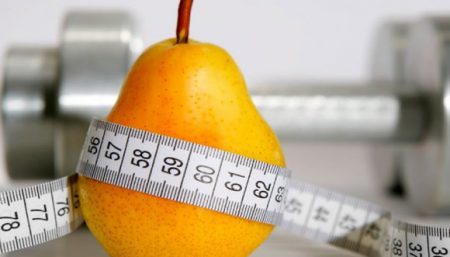
In physically inactive people there is a loss of about [-0.5%] of lean muscle mass every year between age 25 and 60, and a corresponding decline in muscle strength. From age 60 on, the rate of loss doubles, to about 1%. It doubles again at age 70; again at age 80, and then again at age 90.
With age we are losing muscle mass, and that muscle mass is being replaced by fat cells. Typically an individual wonders why they develop a “pouch” gut, or why their thighs or buttocks are becoming larger. We realize we are not gaining muscle mass in these areas, but losing muscle mass and fat cells are gaining in size. Most people can envision this process occurring in their body from the age of 30 on. As strength goes, so does physical functioning—the ability to do chores, take walks, climb stairs, or the accomplishment of other activities. This loss of strength can create a vicious cycle. Since it takes a great deal of physical effort and discomfort to perform daily tasks, one naturally avoids it, which creates even more weakness.
The most obvious intervention against sarcopenia is exercise in the form of resistance training. A recent review by the International Osteoporosis Foundation (IOF) Nutrition Working Group has identified nutritional factors that contribute to loss of muscle mass, or conversely, can prove beneficial in the maintenance of muscle mass.
The IOF Group reviewed evidence from worldwide studies on the role of nutrition in sarcopenia (gradual loss of muscle mass), and identified the following important nutritional factors that have been shown to be beneficial to the maintenance of muscle mass and the treatment and prevention of sarcopenia:

- Protein: Protein intake plays an integral part in muscle health. The authors propose an intake of 1.0–1.2 g/kg of body weight per day as optimal for skeletal muscle and bone health in elderly people without severely impaired renal function. Vary your protein sources so you get the full range of amino acids. Good sources include fish, chicken, lean red meat, turkey, skim milk, low-fat cottage cheese, Greek yogurt, eggs and whey protein.
- Vitamin D: Role of vitamin D is critical in the develop-ment and preservation of muscle mass and function. Older people are prone to develop vitamin D deficiency because of various risk factors: decreased dietary intake, diminished sunlight exposure, reduced skin thickness, impaired intestinal absorption, and impaired hydroxylation in the liver and kidneys. Muscle weakness due to vitamin D deficiency is predominantly of the proximal muscle groups and is manifested by a feeling of heaviness in the legs, tiring easily, and difficulty in mounting stairs and rising from a chair; the deficiency is reversible with supplementation. Adequate vitamin D should be ensured through exposure to sunlight and/or supplementation if required. Vitamin D supplementation in seniors, and especially in institutionalized elderly, is recommended for optimal musculoskeletal health. Getting adequate amounts can depend on regular exposure to the sun’s UVB rays. In addition to being photoconverted in the skin, vitamin D can be obtained from the diet through ingestion of vitamin D–containing products (eg, fatty fish), from vitamin D–fortified milk or margarine, and from the use of multivitamins. The vitamin D ingested via this route is metabolized in the same manner as is endogenously produced vitamin D.
- Avoid dietary acid loads: Modify your diet to include more fruits and vegetables in order to benefit both bones and muscles. Excess intake of acid-producing nutrients (meat and cereal grains) in combination with low intake of alkalizing fruits and vegetables may have negative effects on musculoskeletal health. Acid – base homeostasis is critical to health and it is well documented that extracellular fluid pH remains between 7.35 and 7.45. A major requirements therefore of our metabolic system is to ensure that hydrogen ion concentrations are maintained between 0.035 and 0.045 m Eq/L. Acid-forming foods (protein and carbohydrates) drain calcium from the bones; alkalizing foods (fruits, vegetables, seaweeds) neutralize the acids and prevent calcium drain.

- Vitamin B12: plays a role in improving muscle function and strength. Vitamin B12 is only found in animal products, such as meat, dairy, eggs, and seafood. Studies have shown that people in their older years (50 an older) lose the ability to absorb adequate amounts of vitamin B12 from meat or dairy products. This is where vitamin B supplements can be required. Clams are an excellent source of vitamin B12 and copper. These nutrients may help maintain good blood status for delivering oxygen to working muscles.
- Folic acid: Necessary for DNA & RNA synthesis, which is essential for the growth and reproduction of all body cells. It is essential to the formation of red blood cells by its action on the bone marrow. It also aids in amino acid metabolism. An excellent source of folic acid are cereals that have been fortified with 100%DV (400 mcg) of folic acid.
Along with proper nutrition, a powerful intervention in the prevention and treatment of sarcopenia is resistance training (weight-lifting or strength training). Resistance training works to build muscle by forcing the body to heal the damage to muscle cells that occur with use. When the intensity is high enough, microscopic tears occur in the muscle, which then rebuild protein and make the muscle stronger.
Disclaimer
The Content is not intended to be a substitute for professional medical advice, diagnosis, or treatment. Always seek the advice of your physician or other qualified health provider with any questions you may have regarding a medical condition.



